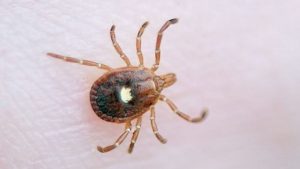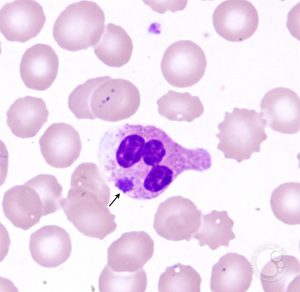Summary
Ehrlichiosis is a bacterial disease that spreads to humans through a tick called Amblyomma americanum. The bacteria that the tick carries and causes this disease is Ehrlichia chaffeensis. Most people who are bitten by this tick don’t encounter symptoms, but the ones that do, experience symptoms such as fever, headaches, muscle pains, chills, nausea, vomiting, etc. Symptoms usually begin within a week. Anyone who experiences like symptoms should be treated immediately or more severe symptoms can occur. A popular treatment for Ehrlichiosis is tetracycline antibiotics. Tetracycline treats bacterial infections by stopping the growth of the bacteria.
Fact Table
| Formal binomial name of microbe: | Ehrlichia chaffeensis |
| Gram stain (gram positive, gram negative or neither): | Gram-negative |
| Is the microbe mobile or immobile? | Immobile |
| Primary habitat? (Where is the organism normally found or prefer to live?) | -Found:human leukocytes and tissues
-Grow in Cytoplasmic vacuoles |
| Can the organism infect humans? | Yes |
| Can the organism infect other species? If so, which ones. | Yes, white-tailed deer, dogs, and several other vertebrates |
| Documented cases of antimicrobial resistance? | Studies are still going on |
| Number of infections per year in the US | -In 2017 1,642 and has increased over the years
–Most common in the southeastern, south-central, and mid-Atlantic regions of the U.S. |
| Number of infections per year in the world | Could not find |
Description
Ehrlichiosis is an infection that is more likely to happen in the spring and summer seasons. People who spend their time outside are at higher risk for Ehrlichiosis. A person who was bitten by a tick should see their healthcare provider immediately. Below in the first picture, there is the tick called the lone star tick that carries the bacteria Ehrlichia chaffeensis.


Lone Star ticks are usually brown with eight legs and can move very quickly. Their body size is very similar to other kinds of ticks.
When approaching a healthcare provider about getting a bite he/she will do a physical examination. He/she will then take tests in order to diagnose. Some tests that will be done are Indirect immunofluorescent assay, white blood cell examination, and polymerase chain reaction. The Indirect immunofluorescent assay will be done first since it takes about 21 days to diagnose. When looking at white blood cells under a microscope the bacteria may be seen inside. In the second photo, the bacteria is shown in a white blood cell. After the tests, the treatments will then be discussed.
If ehrlichiosis is not treated hospitalization and life-threatening symptoms can occur. Some life-threatening symptoms are kidney failure and respiratory problems. For some people, it can take up to fourteen days to actually see signs and symptoms. If your a nature person some ways to avoid ehrlichiosis are using tick repellents and wearing light-colored clothing. Light-colored clothing makes it easier to see the ticks. Always check all clothing after spending time outside. Ticks are usually found outside in shaded, moist areas.
News Articles
- Tick-borne diseases are increasing, but the weather doesn’t play a role in increasing the tick population. Animals are what influences the tick population because they serve as hosts for the ticks. Since tick-borne diseases are increasing people need to start taking extra precautions. “Is Climate Change to Blame? Will tick-borne diseases increase?”
- If a pet has a tick then the best way to have it removed it professionally. To avoid ticks on pets it’s best to stay out of areas of tick infestation. There are many products that can help prevent ticks on pets. “Animal Health with Helen Woodword Animal Center: Ticks”
- Some red meat allergies are caused by the lone star ticks. People who have been bitten by the lone star tick are developing hives around the bite mark. “How a Tick Bite Can Give You a Red Meat Allergy”
Reference List
“Ehrlichiosis”;Cedars-Sinai;
https://www.cedars-sinai.org/health-library/diseases-and-conditions/e/ehrlichiosis.html
“Human Monocytic Ehrlichiosis(HME)”;Nord;
https://rarediseases.org/rare-diseases/human-monocytic-ehrlichiosis-hme/
“Ehrlichiosis”;Columbia University Irving Medical Center;
https://www.columbia-lyme.org/ehrlichiosis